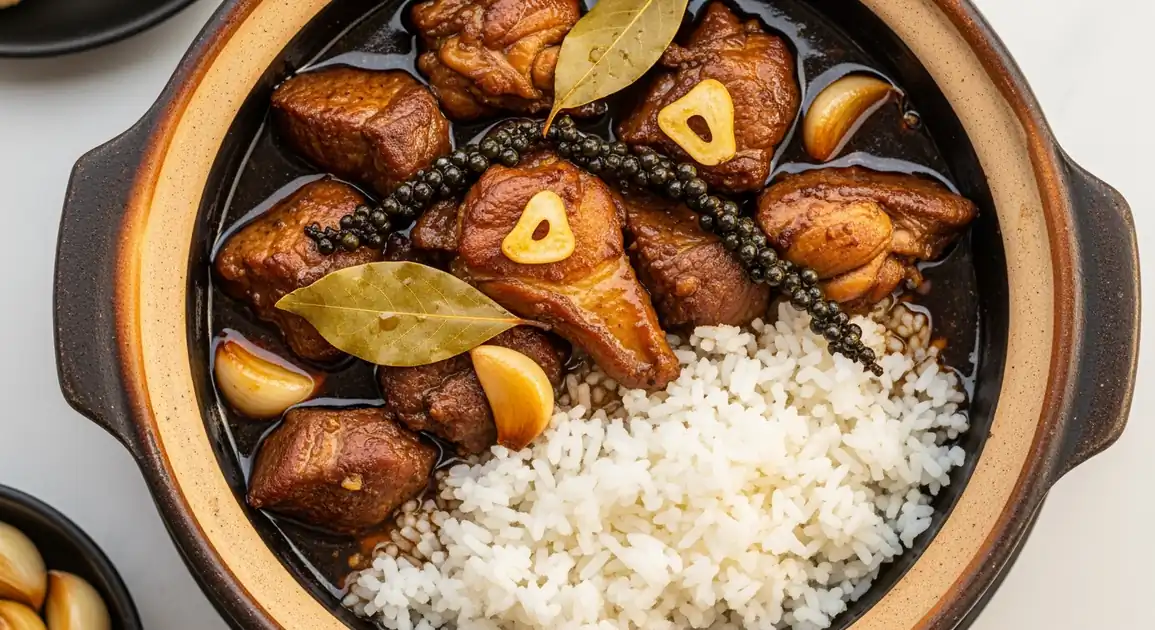Adobo in Philippines: A Complete Food Lover's Guide
Adobo

Understanding This Dish: An Introduction
Adobo is the beloved unofficial national dish of the Philippines, consisting of meat (typically chicken, pork, or both) simmered in a distinctive marinade of vinegar, soy sauce, garlic, black peppercorns, and bay leaves. This cooking method originated as a preservation technique in the pre-refrigeration era, with the acid and salt naturally extending the food's shelf life in the tropical climate. Each Filipino family treasures their own version, making adobo a dish with countless variations yet instantly recognizable by its savory-tangy flavor profile.
Traditional Preparation Techniques
Traditional adobo preparation begins with marinating meat in vinegar, soy sauce, crushed garlic, bay leaves, and whole peppercorns (some recipes add sugar or other seasonings). The meat is then simmered in this mixture until tender, allowing it to absorb the flavors while the liquid reduces to a rich sauce. Some versions brown the meat before or after simmering for added depth. The slow cooking process tenderizes tougher cuts of meat while developing complex flavors. Many households prepare large batches as adobo improves with age when properly stored, with leftover adobo commonly transformed into crispy 'adobo flakes' for breakfast.
Key Ingredients of Adobo
Vinegar (Cane or Palm)
The defining ingredient, providing the signature tangy flavor and acting as a natural preservative. It should be balanced, not overly acidic.
Quality indicator: Look for a pleasant, sharp aroma and a clean, bright taste that complements the other flavors.
Soy Sauce
Contributes umami, saltiness, and a rich, dark color to the sauce. The quality and type of soy sauce significantly impact the final flavor.
Quality indicator: A good quality soy sauce will have a balanced saltiness and a deep, complex umami profile without being overly bitter or thin.
Garlic
Used generously, garlic provides a pungent, aromatic base that mellows and sweetens during the long simmering process.
Quality indicator: Fresh, plump garlic cloves that are crushed or minced will release the most potent and desirable aroma and flavor.
Bay Leaves & Black Peppercorns
These aromatics infuse the sauce with subtle herbal and peppery notes, adding complexity without overpowering the main flavors.
Quality indicator: Whole, intact bay leaves and freshly crushed or whole black peppercorns indicate traditional preparation and contribute to a richer aroma.
Enhancing the Flavor: Classic Pairings
Steamed White Rice
staple
The essential accompaniment to adobo, plain white rice perfectly soaks up the rich, tangy, and savory sauce, balancing its intense flavors and making it a complete meal.
Atchara (Pickled Papaya)
condiment
This sweet and sour pickled green papaya, often with carrots and bell peppers, offers a refreshing counterpoint to the richness of adobo, cleansing the palate with its tangy crunch.
From Humble Origins: A Brief History
Adobo's origins blend pre-colonial Filipino cooking methods with influences from Chinese traders (soy sauce) and Spanish colonizers (who named it after their own 'adobar' marinade). Before Spanish contact, Filipinos were already cooking meat in vinegar and salt. The addition of soy sauce came later through Chinese trade. While the Spanish named the dish, Filipino adobo remains distinctly different from Spanish or Latin American versions. Through generations, adobo evolved with regional variations across the 7,000+ Philippine islands, becoming a cultural touchstone that reflects the country's complex history of indigenous practices and foreign influences.
Local Adobo Variations in Philippines
Chicken Adobo
Made with chicken pieces (typically bone-in thighs and legs), resulting in a lighter-colored sauce than pork versions.
Pork Adobo
Prepared with pork belly or shoulder, producing a richer, fattier dish with more depth of flavor.
Chicken and Pork Adobo
The classic combination using both meats, offering varied textures and flavors in one dish.
White Adobo
Traditional version using salt instead of soy sauce, resulting in a pale sauce that highlights the vinegar flavor.
Yellow Adobo
Uses turmeric instead of soy sauce, giving the dish a golden color and earthy flavor.
Universal Quality Indicators
What to Look For
-
Properly cooked meat that falls off the bone (chicken) or is fork-tender (pork)
Fully cooked meat ensures safety while achieving the ideal adobo texture. The meat should be tender but not mushy.
-
Clear, glossy sauce with visible whole spices
Quality adobo has a reduced, somewhat glossy sauce from rendered fat. The presence of whole peppercorns and bay leaves indicates traditional preparation.
-
Food served hot or properly refrigerated and reheated
While adobo's vinegar and salt act as preservatives, proper temperature control remains important, especially in hot climates.
-
Clean serving environment with proper food handling
Look for vendors who use clean utensils, covered containers, and good hygiene practices.
What to avoid
-
Pre-cooked adobo sitting at room temperature for extended periods
Despite its preservative qualities, adobo should not sit at room temperature all day, especially in hot weather.
-
Excessively oily or greasy appearance
While adobo naturally contains fat, excessive oil floating on top may indicate poor preparation or quality issues.
-
Very dark, almost black sauce
Extremely dark sauce may indicate overuse of soy sauce, burnt garlic, or old, repeatedly reheated adobo.
-
Adobo with an overly sour or fermented smell
While adobo should be tangy, an extremely sour smell might indicate spoilage or poor-quality vinegar.
Explore Adobo in Detail: City Guides
Discover where to find the best Adobo and learn local tips in these cities:
Dietary Information
Dietary Information
Important Note for Travelers: Your safety is our priority. Below are the common allergens associated with the traditional preparation of this dish. However, recipes and ingredients can vary significantly between establishments. Always confirm all ingredients directly with the food vendor before ordering, especially if you have a severe allergy.
Potential Allergens
Dietary Suitability
How to Order Adobo
Frequently Asked Questions about Adobo
What is Filipino Adobo?
Adobo is the unofficial national dish of the Philippines, consisting of meat (usually chicken, pork, or both) marinated and simmered in a sauce of vinegar, soy sauce, garlic, bay leaves, and black peppercorns. The cooking process involves braising the meat until tender, with the sauce reduced to a rich, flavorful consistency. The name comes from the Spanish word 'adobar' (to marinate), though the Philippine version is distinct from Spanish or Latin American adobo.
What makes a good authentic Adobo?
Authentic Filipino Adobo should have tender meat that's absorbed the flavors of the marinade, with a perfect balance of savory, tangy, and slightly sweet notes. The sauce should be rich but not overly thick, with visible whole peppercorns and bay leaves. Good adobo has a characteristic sheen from fat rendered during cooking. Regional variations exist, but quality indicators include meat that falls off the bone (for chicken) or fork-tender (for pork), a complex aroma of garlic and vinegar, and a deep color from proper simmering.
How to choose quality Adobo from street vendors?
Adobo's high vinegar and salt content offers natural preservation, making it a good choice from vendors. For optimal quality, select vendors with high customer turnover, ensuring freshness. Confirm the adobo is served hot or properly reheated, and observe for clean serving areas. Prioritize establishments that prepare adobo fresh daily. While adobo often tastes better after a day, it should not be kept unrefrigerated for extended periods.
What are the main variations of Filipino Adobo?
Filipino Adobo boasts numerous regional and family variations. Common types include Adobong Manok (chicken), Adobong Baboy (pork), and the combined Adobong Manok at Baboy. Other notable versions are Adobo sa Dilaw (with turmeric) and Adobong Puti (using salt instead of soy sauce). You might also find soupy versions (Adobong Masabaw), those with coconut milk (Adobo sa Gata), or sweeter preparations. Seafood, vegetable, and even fruit adobos also exist.
Is Adobo vegetarian or vegan-friendly?
While traditional Adobo is meat-based, vegetarian and vegan versions are available using ingredients like tofu, mushrooms, eggplant, or kangkong. When ordering, confirm vegetable-based sauces are used, as some may contain meat broths or fish sauce. For vegans, also verify no animal products like honey are used for sweetening. These plant-based options retain the characteristic vinegar-soy-garlic flavor profile.
How is Adobo traditionally served?
Adobo is traditionally served as a main dish with steamed white rice (kanin), which is essential for soaking up the flavorful sauce. It's commonly presented family-style in a communal dish at the center of the table, or as individual portions with rice on the side. Common accompaniments include sliced tomatoes, ensaladang mangga (green mango salad), atchara (pickled papaya), or itlog na maalat (salted egg). Adobo is often enjoyed with a spoon and fork, the typical Filipino dining utensils.
Expert How-To Guides about Adobo
How to Spot Authentic Adobo
Learn to identify true Filipino adobo with these quality indicators.
- Look for a balanced sauce color - not too dark (over-soy) or too light (under-reduced).
- Check for visible whole peppercorns, bay leaves, and garlic pieces in the dish.
- The meat should be fork-tender but not falling apart or mushy.
- The sauce should have a glossy appearance from rendered fat, not looking watery.
- Smell for the signature aroma blending vinegar, garlic, and bay leaf.
- Quality adobo has a multi-dimensional flavor - savory, tangy, slightly sweet with a peppery finish.
How to Choose the Best Adobo Vendor
Tips for selecting restaurants or vendors serving quality adobo.
- Look for places with high customer turnover, as adobo should be made fresh daily.
- Ask if it's today's batch ('Bagong luto ba ito?') - freshly made is ideal, though adobo can taste even better after sitting overnight in refrigeration.
- Check cleanliness of the establishment and serving containers.
- Observe if the adobo is kept at proper temperature (hot, or refrigerated and reheated).
- Look for specialty places that are known specifically for their adobo.
- At 'turo-turo' eateries, select adobo from containers that are being regularly replenished.
How to Eat Adobo Like a Local
Enjoy adobo the Filipino way with these cultural tips.
- Always eat adobo with rice - it's considered the perfect vehicle for the sauce.
- Use a spoon and fork (not knife) - the Filipino way is to use the fork to push food onto the spoon.
- Try the 'sabaw' (sauce) drizzled over your rice even before eating the meat.
- Appreciate leftover adobo - many Filipinos believe adobo tastes better the next day as flavors develop.
- Don't be afraid to use your hands for bone-in chicken pieces (called 'kamayan' style).
- Try adobo with side dishes like ensaladang mangga (green mango salad) for a balanced meal.
Our Commitment to Quality
At Tasteplorers, our mission is to provide the most accurate and useful travel information in the world. To achieve this, all content on this site is created through our unique editorial framework. We utilize leading AI research tools, guided by our proprietary prompts, and a multi-stage validation process. This entire system is overseen by our editorial team to ensure everything we publish meets our high standards for accuracy, cultural nuance, and practical value for travelers.
Learn more about our Editorial Process and our Mission.
Countries
Explore regions
Europe
Discover Europe's diverse culinary landscape, from Mediterranean flavors to hearty Alpine fare. Learn to navigate markets, decode menus, and eat like a local.
Latin America & Caribbean
Discover the vibrant cuisines of Latin America & the Caribbean. Our expert guide covers everything from Mexican street food to Peruvian ceviche and market tips.
Oceania
Explore Oceania's diverse food scene. Learn about Polynesian earth ovens, Fijian feasts, and the vibrant café culture of Australia and New Zealand.
Southeast Asia
Explore Southeast Asia's diverse food cultures from Thailand to Vietnam. Get expert tips on navigating spice levels, choosing quality vendors, and understanding the rich traditions of the region.








